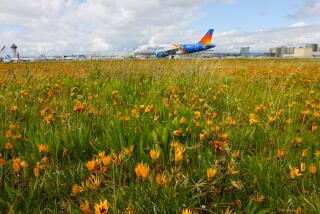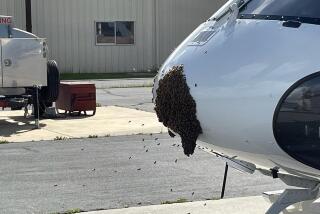30 never-before-seen species of flies discovered in Los Angeles
Scientists have found 30 never-before-seen species of flies buzzing about in the city of Los Angeles.
The discovery suggests that we know less about the diversity of our winged neighbors than was previously thought.
The flies are all members of the phorid family, and were captured in 30 insect traps set up in the backyards of homeowners around the city. Phorid flies are a little smaller than the fruit flies that hover over your bananas.
“Most people don’t even notice them, but they do an incredible array of different things that are important to helping our ecosystem function,” said Brian Brown, curator of entomology at the museum and a phorid fly expert.
Some phorids prey on insect pests, others eat fungi, and still others eat decaying matter. There is even a species known as the coffin fly that can burrow several feet into the dirt to lay their eggs in a corpse.
“Really, the world couldn’t function without these small creatures,” Brown said.
All 30 flies were discovered through a collaboration between the Museum of Natural History of Los Angeles and citizen scientists around the city called BioScan (Biodiveristy Science: City and Nature).
BioScan is a three-year investigation of insect biodiversity in Los Angeles. The 30 homeowners were recruited by the museum to put insect traps in their backyards beginning in 2014. These volunteers are responsible for changing out the collection tubes in their traps every week. They hand the insects they have collected over to a museum representative every few weeks.
Brown said the number of insects collected each week varies by the time of year and where the backyard is, but even in winter, when insect activity is low, each tube can easily have a thousand specimens in it.
The new species were described by Emily Hartop, assistant collections manager for entomology at the museum, in a paper that will be published in the journal Zootaxa on April 6.
Hartop has looked at more than 35,000 phorid flies under a microscope over the last year to determine their species. Most of the time her microscope was aimed at the flies’ genitalia, which is the easiest way to tell the different species apart.
“I’m going to say 90% of our identification work focuses on these for flies,” she wrote in a blog post, “we are obsessed with fly genitalia…”
In the accompanying image, you can see the sketches she made of the different types of genitalia she came across.
Hartop said all the new flies described in the paper were collected in the first three months of 2014 -- the first year of the project. Since writing the paper, she has continued to make her way through more samples, and has already discovered some additional species.
Phorids are just a small fraction of the bugs collected by the BioScan project. Other researchers are already looking at the different species of butterflies, ladybugs and bees that live in L.A. as well.
And once scientists are better aware of the winged animals that share our city, they can better monitor changes in that population and what those changes might be telling us.
“People are healthier when they are surrounded by biodiversity,” Brown said. “Making the city more conducive to biodiversity is going to make it a better place for everyone to live.”
Science rules! Follow me @DeborahNetburn and “like” Los Angeles Times Science & Health on Facebook.
ALSO:
View to a kill: Helmet-wearing hawk films its own hunting tactics
Happy face or angry face? A dog can tell the difference, study finds
Menopausal whales lead the group, study says







